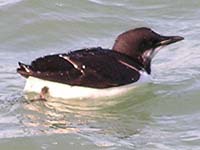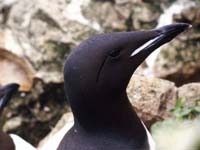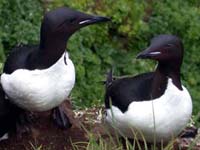THE WORLD BIRDS - An Online Bird Book
GULLS and Allies
AUKs
Order Charadriiformes Family Alcidae
GULLS and Allies
Gulls, terns, skimmers, skuas, puffins, and their allies belong to the order Charadriiformes. Charadriiformes is a diverse order and contains many other families. Most live near water and eat invertebrates or other small animals; however, some are pelagic (seabirds), some occupy deserts and a few are found in thick forest.
AUKs
Order Charadriiformes Family Alcidae
Auks and their allies (auklets, guillemots, razorbills, puffins) are superficially similar to penguins due to their black-and-white colours, their upright posture and some of their habits. Nevertheless they are not closely related to penguins. Their closest living relatives appear to be the skuas, Auks have to a large extent sacrificed flight, and also mobility on land, in exchange for swimming; their wings are a compromise between the best possible design for diving and the bare minimum needed for flying. The auks are restricted to cooler northern waters. Their ability to spread further south is restricted by their prey hunting method, pursuit diving. This becomes less efficient in warmer waters. The speed at which small fish can swim doubles as the temperature increases from 5°C to 15°C, with no corresponding increase in speed for the bird. Auks live on the open sea and only go ashore for breeding. They vary from 15-45 cm.
Genus Aethia
The auklets occur in the North Pacific and Bering Sea.
Auklet,_Crested Aethia cristatella Found: North Pacific including western North America, northern Asia
The Crested Auklet has dark gray body; black forehead crest; reddish-orange and yellow tipped bill; white eyes; white plume projecting back from the eye. Females are slightly smaller than males.
Similar to: Parakeet Auklet. Crested Auklet has tuft of feathers on top of head; Parakeet Auklet does not.
Image by: 1) Alan D. Wilson- Zapadni Cliffs, St. Paul Island, Alaska 2) F Deines, USFWS 3) Gregory_Smith - AlaskaSimilar to: Parakeet Auklet. Crested Auklet has tuft of feathers on top of head; Parakeet Auklet does not.
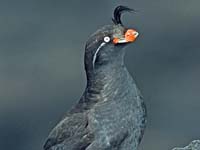

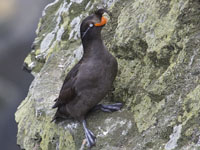
Auklet,_Least Aethia pusilla Found: North America (Alaska), Asia
The breeding Least Auklet has dark gray upperparts; speckled undersides, white throat; white eyes; dark bill with reddish tip. Nonbreeding has white undersides with no speckles.
Similar to: Little Auk. Little Auk has white underside; Least Auklet has speckled underside.
Similar to: Whiskered Auklet. Whiskered Auklet has more impressive whiskers and also more prominent eye line. Least Auklet is the smallest Auklet species.
Image by: Alan D. Wilson - Zapadni Breakwater, St. Paul Island, AlaskaSimilar to: Little Auk. Little Auk has white underside; Least Auklet has speckled underside.
Similar to: Whiskered Auklet. Whiskered Auklet has more impressive whiskers and also more prominent eye line. Least Auklet is the smallest Auklet species.
1, 2, 3) Breeding
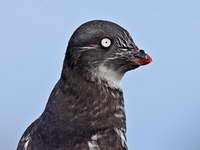
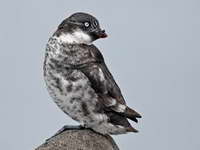
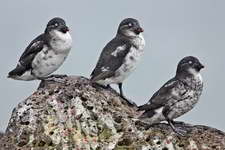
Auklet,_Parakeet Aethia psittacula Found: Found: west North America, east Asia
The Parakeet Auklet has dark gray upperparts, white underparts; white plume projecting back from the eye; white eyes; speckled flacks, breast; short orange upturned bill. There is a small variation between breeding and winter plumage.
Similar to: Crested Auklet. Crested Auklet has tuft of feathers on top of head; Parakeet Auklet does not.
Image by: 1, 2) Alan D. Wilson - St. Paul Island, Alaska 3) Art Sowls, USFWSSimilar to: Crested Auklet. Crested Auklet has tuft of feathers on top of head; Parakeet Auklet does not.
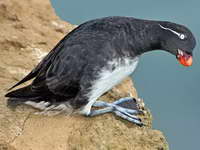
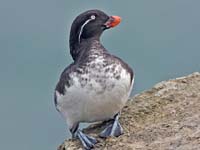
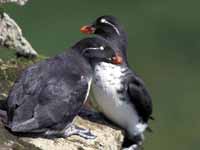
Auklet,_Whiskered Aethia pygmaea Found: North America (Alaska) and Asia (Aleutian Islands and some islands off Siberia)
The Whiskered Auklet is dark gray. It has white whiskers on the side of the face; whispy black tuft on forehead; orange bill. Winter adult is duller; has white belly.
Similar to: Least Auklet. Whiskered Auklet has more impressive whiskers. Least Auklet is the smallest Auklet species.
Similar to: Rhinoceros Auklet. Breeding Whiskered auklet has black tuft on forehead; Rhinocerous Auklet does not, but it does have 'horn' on its bill.
Image by: 1) L. Lauber, USFWS 2) USFWS 3) Mckenzie_MudgeSimilar to: Least Auklet. Whiskered Auklet has more impressive whiskers. Least Auklet is the smallest Auklet species.
Similar to: Rhinoceros Auklet. Breeding Whiskered auklet has black tuft on forehead; Rhinocerous Auklet does not, but it does have 'horn' on its bill.
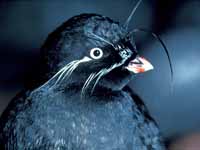
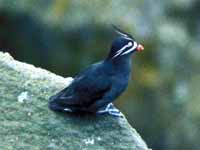
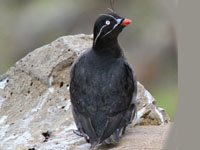
Genus Alca - 1 species
Razorbill Alca torda Found: North Atantic coasts, including those of North America
The Razorbill has black upperparts; white underparts; thick black bill with blunt end and vertical white line. The breeding adult has white line from the eye to top of bill. The nonbreeding adult has white lower face and throat.
Similar to: Common Murre, Thick-billed Murre. Bill of Razorbill is blunt at the end; bill of Common Murre and Thick-billed Murre is pointed.
Image by: 1) Wildlifeshoots - Florida! 2, 3, 4, 5, 6) Dick Daniels - Great Britain Similar to: Common Murre, Thick-billed Murre. Bill of Razorbill is blunt at the end; bill of Common Murre and Thick-billed Murre is pointed.
1) Nonbreeding 2 - 6) Breeding
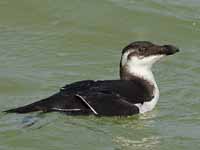
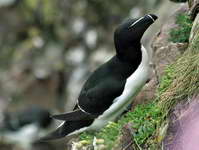
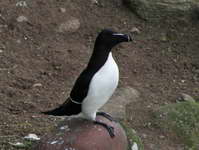

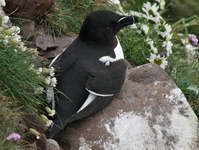
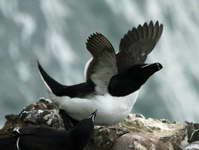
Genus Alle - 1 species
Auk, Little also Dovekie Alle Alle Found: Arctic region ( North America, Europe, Asia)
The breding Little Auk has a black back, neck, back and wings; white underparts; short and stubby black bill. The nonbreeding adult has a lower face and fore neck.
Similar to: Least Auklet. Little Auk has white underside; Least Auklet has speckled underside.
Image by: 1) Olafur Larsen 2) MPF 34) Blake Maybank - Nova Scotia 4) Michael Haferkamp 5) Alastair Rae 6) Harold_Olsen_NTSU - Norway 7) Charlie Westerinen - eastern Greenland Harold_Olsen_NTSU 8) Dick Daniels - exhausted at Sunset Beach, North CarolinaSimilar to: Least Auklet. Little Auk has white underside; Least Auklet has speckled underside.
1, 2, 3) nonbreeding 4, 5, 6, 7) breeding
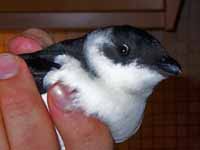
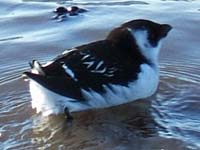
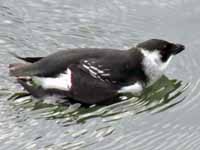
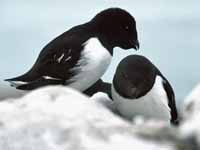
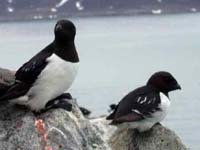
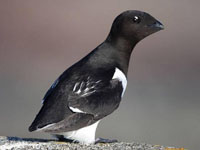

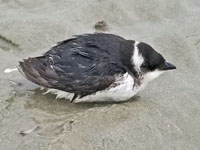
Genus Brachyramphus
Murrelet,_Kittliz's Brachyramphus brevirostris Found: west coast North America, Asia
The breeding Kittliz's Murrelet is gray-brown; has light colored neck. The nonbreeding adult has black and white back; black cap which does not cover the eyes; white collar and throat; white underparts. Unlike most most seabirds, it is not colonial. It nests in isolated locations.
Similar to: Marbled Murrelet. Bill of Kittliz's Murrelet is shorter than that of Marbled Murrelet. Nonbreeding Kittliz's Murrelet has more white on head than nonbreeding Marbled Murrelet. Breeding KIttliz's Murrelent is lighter in color than breeding Marbled Murrelet.
Image by: 1) Alyson McNight, USFWS - Alaska 2) DoedSimilar to: Marbled Murrelet. Bill of Kittliz's Murrelet is shorter than that of Marbled Murrelet. Nonbreeding Kittliz's Murrelet has more white on head than nonbreeding Marbled Murrelet. Breeding KIttliz's Murrelent is lighter in color than breeding Marbled Murrelet.
1) Juvenile 2) Breeding
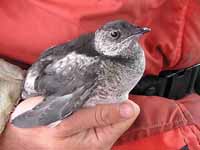
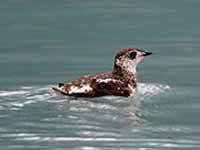
Murrelet,_Long-billed Brachyramphus perdix North America, Asia
The breeding Long-billed Murrelet has mostly brown upperparts; white underparts. The nonbreeding adult has black and white back; black cap which extends below the eyes; black nape; white throat; white underparts.
Similar to: Marbled Murrelet. Long-billed Murrelet has a longer bill than Marbled Murrelet. Nonbreeding Long-billed Murrelet has black nape.
Image by: MPF - United KingdomSimilar to: Marbled Murrelet. Long-billed Murrelet has a longer bill than Marbled Murrelet. Nonbreeding Long-billed Murrelet has black nape.
1) Nonbreeding
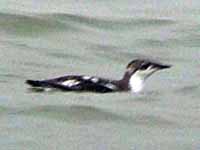
Murrelet,_Marbled Brachyramphus marmoratus Found: west coast North America, Asia
The breeding Marbled Murrelet has mostly brown upperparts; white underparts. The nonbreeding adult has black and white back; black cap which extends below the eyes; white collar and throat; white underparts.
Similar to: Ancient Murrelet. Ancient Murrelet is the only member of family Alcidae with a small yellow bill. Marbled Murrelet has a dark bill which is longer. Both the Marbled and Ancient Murrlet have an incomplete white neck collar.
Similar to: Kittliz's Murrelet. Bill of Kittliz's Murrelet is shorter than that of Marbled Murrelet. Nonbreeding Kittliz's Murrelet has more white on head than nonbreeding Marbled Murrelet. Breeding KIttliz's Murrelent is lighter in color than breeding Marbled Murrelet.
Similar to: Long-billed Murrelet. Long-billed Murrelet has a longer bill than Marbled Murrelet. Nonbreeding Long-billed Murrelet has black nape.
Image by: 1) Rich Macintosh, USFWS 2) Andrew Reding - state of Washington 3) Gus Van Vliet, USFWS 4) USFWS Similar to: Ancient Murrelet. Ancient Murrelet is the only member of family Alcidae with a small yellow bill. Marbled Murrelet has a dark bill which is longer. Both the Marbled and Ancient Murrlet have an incomplete white neck collar.
Similar to: Kittliz's Murrelet. Bill of Kittliz's Murrelet is shorter than that of Marbled Murrelet. Nonbreeding Kittliz's Murrelet has more white on head than nonbreeding Marbled Murrelet. Breeding KIttliz's Murrelent is lighter in color than breeding Marbled Murrelet.
Similar to: Long-billed Murrelet. Long-billed Murrelet has a longer bill than Marbled Murrelet. Nonbreeding Long-billed Murrelet has black nape.
1) Juvenile 2) Nonbreeding 3) Nonbreeding, eclipse 4) Breeding
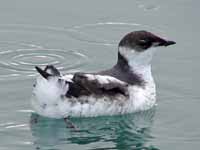

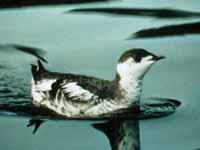

Genus Cepphus
Guillemot, Black Cepphus grylle Found: North America (East coast, down to Massachusetts), NW coast of Europe
The breeding Black Guillemot has black body with white wing patch; thin dark bill; red legs and feet. They show white wing patch in flight. The nonbreeding bird has pale gray upperparts; white underparts. The wings remain black with the large white wing patch.
Similar to: Pigeon Guillemot. Range does not overlap.
Image by: 1) Ómar Runólfsson - Iceland 2) oskaree - iceland 3) nebirdsplus - Massachusetts 4, 5) Dick Daniels - Scotland 6) Christian Bickel 7) Charlie Westerinen - Iceland 8) Mark Medcalf - Scotland 9) Dick - McGee Island, MaineSimilar to: Pigeon Guillemot. Range does not overlap.
1) 1st winter 2, 3) Nonbreeding 4, 5, 6) Breeding 7) Breeding with sand eel 9) With juvenile Common Loon
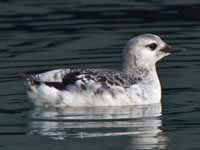
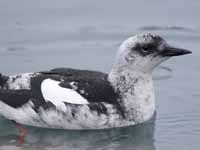
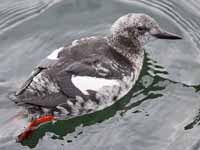
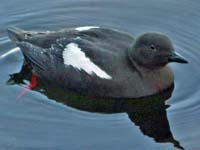
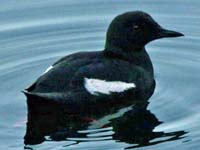
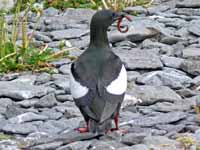
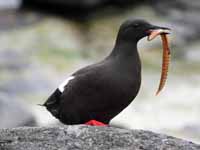
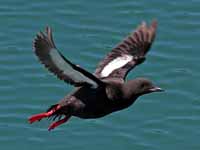
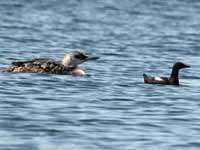
Guillemot, Pigeon Cepphus columba Found: North America, Asia
The Pigeon Guillemot has a black body; white wing patch broken by black wedge; a thin dark bill; red legs and feet. Nonbreeding adult has mottled gray and black upperparts; white underparts.
Similar to: Black Guillemot. Range does not overlap.
Image by: 1) Maggie Smith - California 2, 6, 8) Dick Daniels - Alaska Sea Life Center, Sewrd 3, 4) Dick - Kachemak Bay, Alaska 5) Alan Vernon 7) Schlawe of the USFWS Similar to: Black Guillemot. Range does not overlap.
1) Juvenile 2 - 8) Breeding
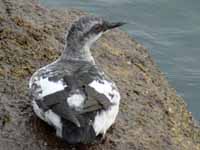
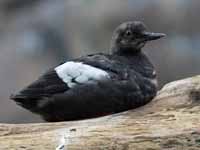

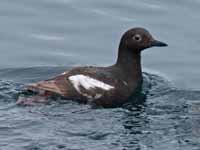
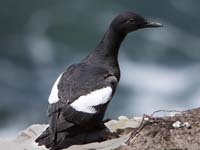
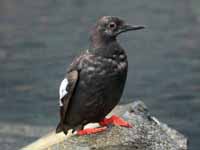
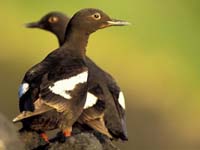
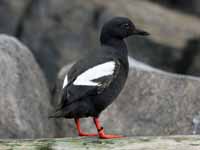
Guillemot, Spectacled also Sooty Guillemot Cepphus carbo Found: Asia
The breeding Spectacled Guillemot is mostly sooty-black. It has white "spectacles"; black bill, black iris; red legs.The nonbreeding adult is similar but has scaly white underparts.
Image by: Eliezg - Yamsky Island in the Sea of Okhotsk, Russia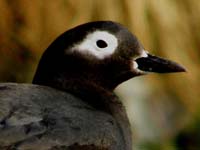
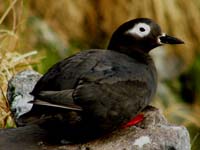
Genus Cerorhinca - 1 species
Auklet,_Rhinoceros Cerorhinca monocerata Found: west North America, east Asia
The breeding Rhinoceros Auklet has a large orange/brown bill with protruding 'horn'; dark upperparts; paler underparts white plumes above the eyes and behind the bill. Nonbreeding bird does not have the 'horn' or white plumes.
Similar to: Whiskered Auklet. Breeding Whiskered auklet has black tuft on forehead; Rhinocerous Auklet does not, but it does have 'horn' on its bill.
Image by: 1) Dow Lambert, USFWS 2, 3, 4, 5) Dick Daniels - Alaska Sea Life Center in Seward Similar to: Whiskered Auklet. Breeding Whiskered auklet has black tuft on forehead; Rhinocerous Auklet does not, but it does have 'horn' on its bill.
1) Juvenile

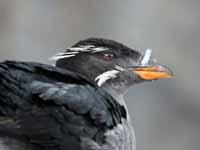

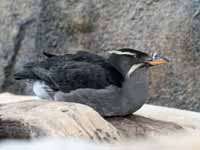

Genus Fratercula
Puffin, Atlantic Fratercula arctica Found: North Atlantic regions of North America and Great Britain
The Atlantic Puffin has black upperparts; white lowerparts; gray to white cheeks; red-orange legs. The bill is large and triangular and during the breeding season is bright orange with a patch of blue bordered by yellow at the rear.
Similar to: Horned Puffin. The ranges of Atlantic Puffin and Horned Puffin do not overlap.
Image by: 1) Erik Christensen - Mykines, Faroe Islands 2) Matthias Meckel - Farne Islands, England
3) Steve Garvie 4, 5) Dick Daniels - Scotland 6) Harold_Olsen_NTSUSimilar to: Horned Puffin. The ranges of Atlantic Puffin and Horned Puffin do not overlap.
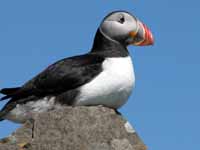
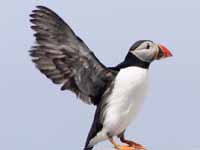
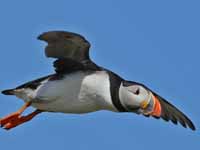
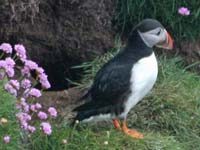


Puffin, Horned Fratercula corniculata Found: Northwest coasts of North America, northeast coast of Asia
The Horned Puffin has black upperparts; white lowerparts; gray cheeks; orange legs. Breeding adult large bill is yellow at base, red at tip.
Similar to: Atlantic Puffin. The ranges of Atlantic Puffin and Horned Puffin do not overlap.
Similar to: Tufted Puffin. Tufted Puffin has yellowish-white tuffs on the head during the breeding season; Horned Puffin does not. Tufted Puffin has black underparts; Horned Puffin has white underparts.
Image by: 1, 2, 3, 4) Dick Daniels - Alaska Sea Life Center in Seward
5) Vernon Byrd, USFWS 6, 8) Alan D Wilson - St. Paul Island, Alaska
7) Dick - Gull Island, Kachemak
Bay, Alaska Similar to: Atlantic Puffin. The ranges of Atlantic Puffin and Horned Puffin do not overlap.
Similar to: Tufted Puffin. Tufted Puffin has yellowish-white tuffs on the head during the breeding season; Horned Puffin does not. Tufted Puffin has black underparts; Horned Puffin has white underparts.
1, 2) Juvenile 3) Nonbreeding 4 - 8) Breeding
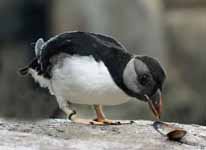
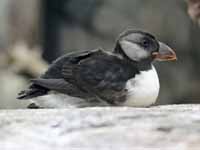

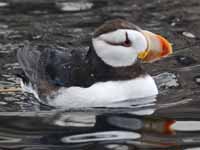
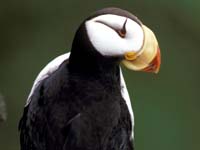



Puffin, Tufted Fratercula cirrhata Found: Northwest coasts of North America, northeast coast of Asia
The Tuffed Puffin has a black body; white facial patch; large yellowish-white tufts. It's thick bill is mostly red with some yellow and occasionally green markings.
Similar to: Horned Puffin. Tufted Puffin has yellowish-white tuffs on the head during the breeding season; Horned Puffin does not. Tufted Puffin has black underparts; Horned Puffin has white underparts.
Image by: 1, 3) Dick Daniels - Gull Island, Kachemak Bay, Alaska 2) Dick - Alaska Sea Life Center in Seward 4, 7) Alan
D Wilson -
St. Paul Island in Alaska 5) Mike Boylan, USFWS 6) Alan -
St. Paul Island Similar to: Horned Puffin. Tufted Puffin has yellowish-white tuffs on the head during the breeding season; Horned Puffin does not. Tufted Puffin has black underparts; Horned Puffin has white underparts.
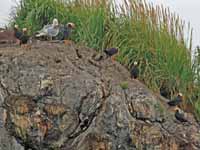


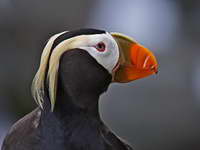
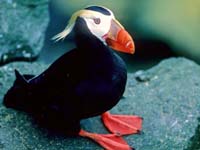

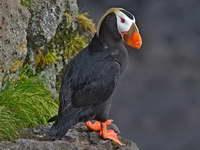
Genus Ptychoramphus - 1 species
Auklet,_Cassin’s Ptychoramphus aleuticus Found: North Pacific including western North America, northern Asia
Cassin's Auklet is generally dark above and pale below, with a small white mark above the eye. Its bill is overall dark with a pale spot, and its feet are blue. Unlike many other auks the Cassin's Auklet lacks dramatic breeding plumage, remaining the same over most of the year.
Image by: 1) Blake Matheson - California 2) Sabrine's Sunbird - Farallon Islands 3) Ducan Wright - Farallon Islands 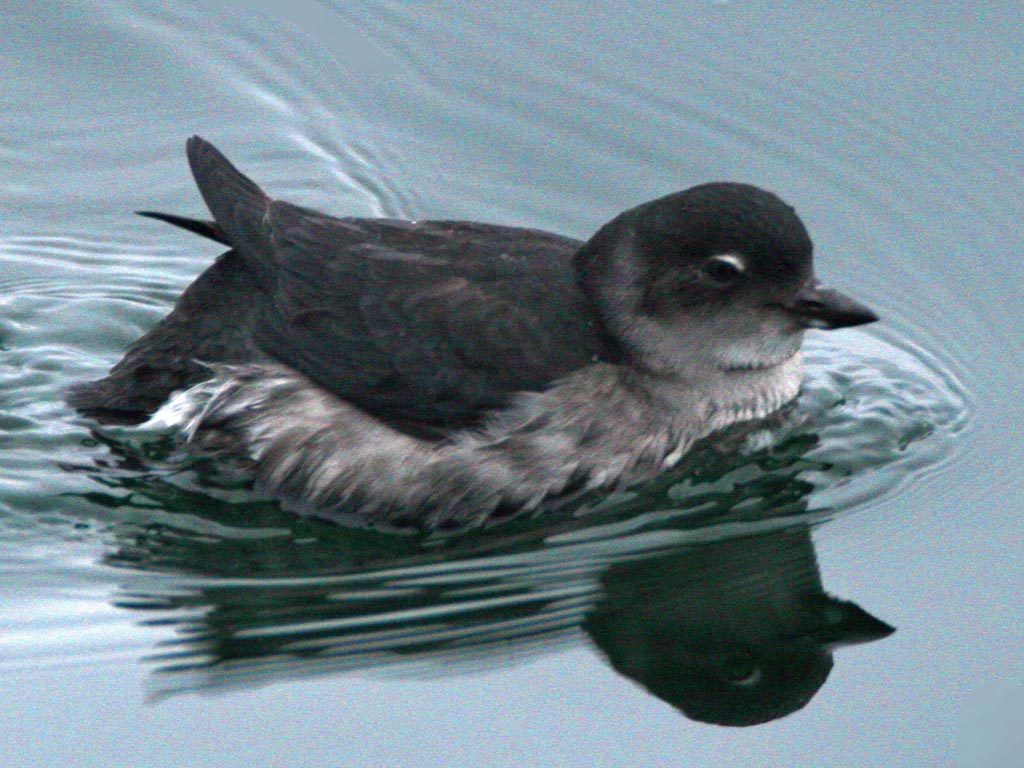
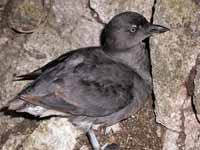
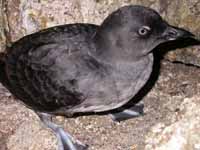
Genus Synthliboramphus
Murrelet,_Ancient Synthliboramphus antiquus Found: North America, Asia
The breeding Ancient Murrelet has black on the head with white streaks (thus the name 'ancient'). It also has black throat, rear neck; gray back; white underparts; short yellowish bill. Nonbreeding adult lacks the crown streaks and black throat.
Similar to: Marbled Murrelet. Ancient Murrelet is the only member of family Alcidae with a small yellow bill. Marbled Murrelet has a dark bill which is longer. Both the Marbled and Ancient Murrlet have an incomplete white neck collar.
Image by: 1) Tom_Benson 2) Eric_Ellingson 3) Andrew Reding Similar to: Marbled Murrelet. Ancient Murrelet is the only member of family Alcidae with a small yellow bill. Marbled Murrelet has a dark bill which is longer. Both the Marbled and Ancient Murrlet have an incomplete white neck collar.
1) Breeding
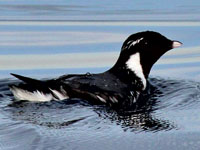
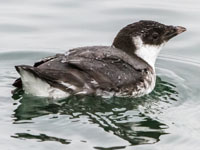
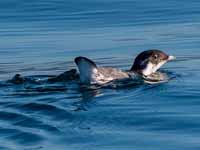
Murrelet,_Craveri's Synthliboramphus craveri Found: California
The Craveri's Murrelet has brownish-black back; black cap which extends below the eyes; white throat; white underparts.
Similar to: Xantu's Murrelet. Craveri's and Xantus's Murrelet are both found off the Calfornia coast. Xantus's Murrelet has a white indentation (small in some some subspecies, large in others) in front of eye. Craveri's Murrelet black / white chin border is smoother.
Image by: 1, 2) Tom BensonSimilar to: Xantu's Murrelet. Craveri's and Xantus's Murrelet are both found off the Calfornia coast. Xantus's Murrelet has a white indentation (small in some some subspecies, large in others) in front of eye. Craveri's Murrelet black / white chin border is smoother.
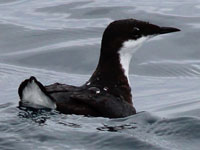
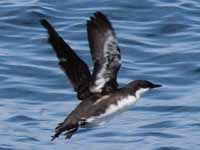
Murrelet,_Guadalupe Synthliboramphus hypoleucus Found: breeds on islands off California and Mexico
The Scripps's Murrelet and Guadalupe Murrelet were formerly conspecific and known as the Xantus's Murrelet. The splitting into two species was based on lack of evidence of interbreeding where the both species nest together on the San Benito Islands, differences in facial pattern, bill shape, and vocalizatons.
Image by: 1) David_Pereksta - Half Moon Bay, CA 2) Arthur Chapman - specimen 3) Tom_Benson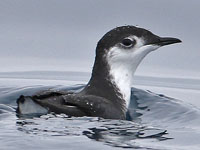
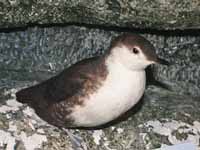
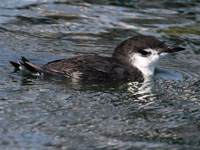
Murrelet, Japanese Synthliboramphus wumizusume Found: Asia
The Japanese Murrelet has bluish-black back; white underparts. It is found in rocky inlets and reefs of Japan, Russia, South Korea.
Image by: 1) Psuedolapiz 2) Hiyashi Haka

Murrelet,_Scripps's Synthliboramphus scrippsi Found: breeds on islands off California and Mexico
The Scripps's Murrelet has blackish upperparts; white throat, underparts. After breeding season it disperse north, as far as British Columbia. The Scripps's Murrelet and Guadalupe Murrelet were formerly conspecific and known as the Xantus's Murrelet.
Image by: 1) National_Park_Service 2) Nordelch 3) Tom_Benson1) Chick
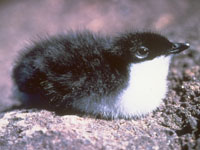
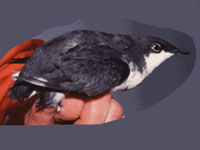
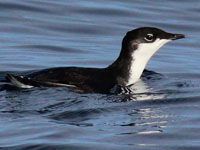
Genus Uria
Murre, Common also Common Guillemot Uria aalge Found: north parts of North America, Europe, Asia, Africa
The breeding Common Muure has brownish-black back, wings, head, throat; white underparts; gray lines on the flanks; thin dark pointed bill; small rounded dark tail; gray legs. Nonbreeding adult has black instead of brownish-black upperparts; white face with black curved eye-line; white thoat.
Similar to: Razorbill. Bill of Razorbill is blunt at the end; bill of Common Murre is pointed.
Similar to: Thick-billed Murre. The Thick-billed Murre has a white gape stripe, the Common Murre never does. The Common Murre may be brindled, not so for the Thick-billed Murre.
Image by: 1, 2, 5) Dick Daniels - Alaska Sea Life Center in Seward 3) Bill Bouton - California 4) Dick - Gull Island, Kachemak Bay, Alaska
6, 7, 8, 9) Dick - Scotland Similar to: Razorbill. Bill of Razorbill is blunt at the end; bill of Common Murre is pointed.
Similar to: Thick-billed Murre. The Thick-billed Murre has a white gape stripe, the Common Murre never does. The Common Murre may be brindled, not so for the Thick-billed Murre.
1) Family 2) First year 3) Nonbreeding 6) Brindled variant
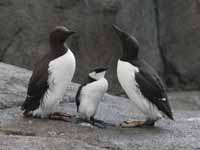
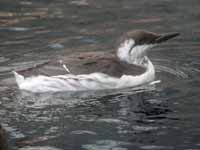
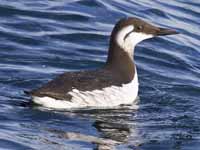

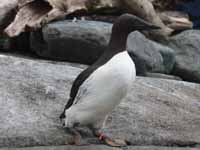

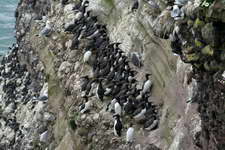
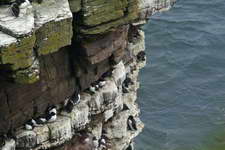

Murre, Thick-billed also Brunnich's Guillemot Uria lomvia Found: North America, Europe, Asia, Africa
The breeding Thick-billed Murre has black upperparts; white underparts; long pointed black bill with a white gape stripe; small rounded black tail. Nonbreeding adult has white lower face and throat.
Similar to: Common Murre.The Thick-billed Murre has a white gape stripe, the Common Murre never does. The Common Murre may be brindled, not so for the Thick-billed Murre.
Similar to: Razorbill. Bill of Razorbill is blunt at the end; bill of Thick-billed Murre is pointed.
Image by: 1) Jcwf 2) Alan D. Wilson - Zapadni Cliffs, St. Paul Island, Alaska 3) Michael Haferkamp - Barentsea, Svalbard 4) US Geoligical Survey Similar to: Common Murre.The Thick-billed Murre has a white gape stripe, the Common Murre never does. The Common Murre may be brindled, not so for the Thick-billed Murre.
Similar to: Razorbill. Bill of Razorbill is blunt at the end; bill of Thick-billed Murre is pointed.
1) Nonbreeding
